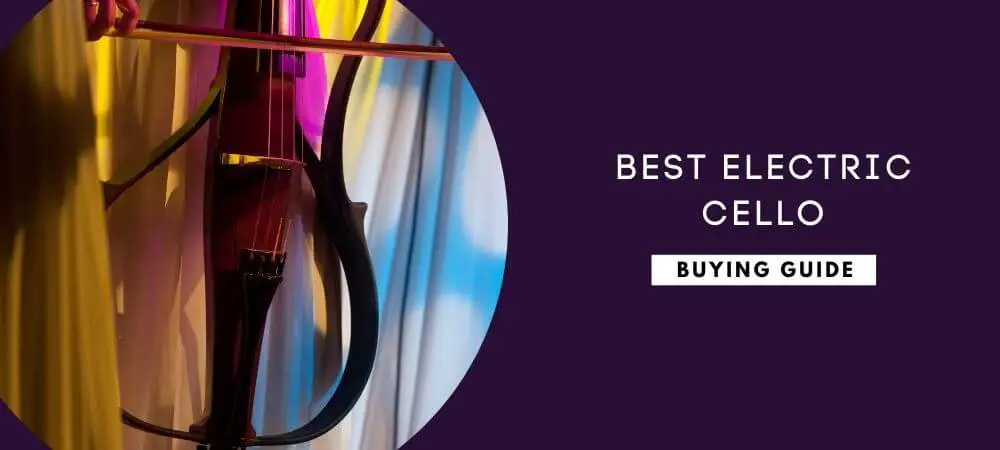Having been around since the 16th century, the acoustic cello has established itself as a critical component in orchestral music.
On the other hand, the electric cello is a fairly new entrant in the market.
From the way it look to how it sounds, the electric cello is almost nothing like its acoustic counterpart.
So why should you get one, and which is the best electric cello your money can buy?
Well, read on and find out.
Table of Contents
Quick Summary
- Overall, the best electric cello we recommend is the Yamaha SVC-210SK Silent Cello.
- If you are looking for an affordably-priced beginner-friendly electric cello, your best bet would be the Cecilio CECO-3DW.
- If you are looking for an electric cello with a more traditional look and feel, we recommend the Yinfente Electric Acoustic Cello.
- For the musician on the go who’s looking for something conveniently compact and portable, our top pick is the Yamaha SVC50SK Compact Cello.
Best Electric Cellos To Buy In 2024
1. Yamaha SVC-210SK Review
The thing about Yamaha is that they are a top-of-the-line brand, and their cellos can be pretty expensive – the SVC-210SK included.
However, your experience of owning a Yamaha electric cello will more than justify its price.
To begin with, this cello comes with a hollow resonating chamber, thereby giving it a naturally full-bodied, acoustic-like warm tone that’s beautifully expressive.
Its fully collapsible compact body was designed entirely for portability.
The slim design features folding leg supports and removable chest and arm supports. This way, you can disassemble it, so it fits perfectly in a compact carrying case.
Setting the instrument up for performance is just as fast and fuss-free. Furthermore, the configuration of this silent cello allows for natural comfort and excellent support while you play it.
Seeing as it comes with a resonating chamber, as well as upper and lower bouts, for the chest and knees, respectively, you are bound to love the acoustic instrument feel of this electric cello.
- Collapsible design for easy portability.
- Deep, warm acoustic-like tone.
- Top-notch craftsmanship.
- Comfortable and easy to play.
- Quite pricey.
2. Cecilio CECO-3DW Review
This Cecilio electric cello has been beautifully hand-carved, so you know that you are investing in a quality instrument that’s been crafted with utmost care.
The hand-carved maple wood electric cello has an ebony fingerboard, and the tailpiece with mother of pearl inlay is a nice touch that enhances the instrument’s elegance.
Additionally, the four detachable fine tuners work pretty great, and you have the option of taking them off entirely.
Keep in mind that this is a complete electric cello outfit.
It comes with a bow, rosin, carrying case, aux out cable, and headphones. Therefore it would be an ideal cello package for a beginner looking for cheap electric cello outfits.
- Budget-friendly.
- Impressive build quality.
- Great sound quality.
- Complete electric cello outfit.
- No lower bouts, therefore slightly awkward to hold.
3. Yinfente Electric Acoustic Cello Review
This hand-carved solid wood electric cello has a solid wood spruce top, while the back features maple wood construction.
The black metallic varnish looks beautifully elegant, further emphasizing the top-tier build quality of this instrument.
This cello has that authentic acoustic look and feel of a traditional cello. Therefore, it would be ideal for cellists looking for just that.
It can produce sound both acoustically and electrically when amplified. Whichever you choose, you will love the charming tone of this instrument.
Similar to other electric cello outfits, this cello package comes with a padded gig bag, a bow, rosin, and an aux cable.
- Great sound quality.
- Quality handcrafted wood construction.
- Traditional look and feel.
- Cannot be used with headphones.
4. NS Design CR6 Cello Review
This stylish electric cello may look tiny, but it is actually pretty sturdy, with a body and neck constructed from solid maple.
Furthermore, the CR6 has three interchangeable support systems to provide performers with endless options, making it a great concert electric cello.
You can go for the tripod stand that can either be used seated or standing up, the shoulder strap that allows for full mobility while on stage, or the endpin stand with traditional chest and knee contact points.
Besides that, this cello uses a dual-mode preamp sound system. The first mode gives you a delicate, more traditional acoustic sound, whereas the second mode allows you to fully explore new territory with a rich, full-blown electric sound.
This multi-dimensional tone has further been enhanced by the instrument’s solid body design, owing to the combination of body resonance and string vibration.
- Excellent acoustic cello sound.
- Sleek portable design.
- Allows for diverse playing styles and positions.
- Sturdy build quality.
- Takes a little getting used to.
5. Aliyes Professional Electric Cello Review
Besides the quality of the strings, the other aspects of an electric cello that influence its sound quality are the electronics used and the quality of the amp.
This Aliyes full-size electric cello uses an electric pickup system that matches up to what Yamaha uses.
As a result, you get good sound quality at a fraction of the cost.
The white noise suppression circuit guarantees that you won’t experience any electronic noise, so the sound output is a clean, clear tone.
This cello not only sounds good, but it looks pretty artistic as well, while at the same time still being comfortable to hold and play, complete with a stainless steel endpin.
The cello outfit includes a soft carrying bag, bow, an aux cable, and an extra set of strings. However, the included strings are not of the best quality. So you might want to replace them with high-quality steel strings for better sound and playability.
- Sleek, stylish design.
- Decent sound quality.
- Lightweight portability.
- 1-year warranty.
- Comes with inferior quality strings.
6. Yamaha SVC50SK Silent Cello Review
The Yamaha SVC50 looks very similar to the SVC210, only smaller and lighter, designed exclusively for convenience and ease of use.
This super lightweight cello’s slim, compact design can easily break down to make it easy for you to carry and transport the cello.
Additionally, the redesigned resonating chamber allows for spacious reverb, producing an impressively full, rich tone.
The chest and leg supports allow for maximum comfort while playing the instrument, so you get the natural feel of a regular cello.
This instrument is equipped with Auxiliary In, Line Out, and Headphone Jacks. Therefore you can not only amplify it but can also connect a disc player, thereby enabling you to feed in accompaniment for your cello solo.
- Compact, disassemblable design for travel.
- Produces a deep rich tone.
- Extremely comfortable to hold.
- Excellent build quality.
- Does not come with a bow.
7. Stagg ECL Electric Cello Review
These electric cello reviews cannot be complete before mentioning the Stagg ECL electric cello.
This super lightweight electric cello features a slim, stylish design, complete with a sleek glossy black finish that looks quite elegant.
The solid maple construction ensures that your instrument will be sturdy, despite its small size.
Additionally, this also contributes to the cello’s full, rich tone.
You have inputs and output jacks on the cello, meaning you can not only amplify your sound but can also play along to your favorite tracks and recordings.
At the same time, you still have the headphones jack, which comes in handy for silent practice sessions.
- Decent sound quality.
- Solid build quality.
- Comfortable to play.
- Adjustable string action enhances playability.
- Inferior quality tuning pegs.
Buying Guide For Electric Cellos: Things To Consider
Why Choose An Electric Cello?
a) Portability
Although electric cellos are typically similarly sized to their acoustic counterparts, the electric models typically weigh far less and are less bulkier than the traditional cello.
At the same time, some electric cellos feature a collapsible design, thereby allowing the instrument to take up very little space while traveling.
b) Sturdiness
Acoustic cellos are excellent, but they pose the slight challenge of being quite vulnerable and delicate, thereby requiring to be handled with extra care.
To begin with, the wooden body of a classical cello is sensitive to humidity and temperature changes. Additionally, this body is more of a wooden husk, so you have to be careful about the slightest knocks and dings, which can result in cracks, thereby affecting the sound quality.
On the other hand, electric cellos are far sturdier. Even those made of wood typically feature solid wood rather than one that’s been hollowed out for acoustic purposes.
Not to mean that electric cellos require less care when handling and transporting them. But rather, they are far much easier to live with.
c) Cheaper
Electric cellos are still relatively costly. However, when comparing models of the same skill level, it would be cheaper to buy an electric cello than it would be to buy an acoustic cello.
The best electric cello brands will cost you between $1,200 and $4,500, depending on the size and skill level of the instrument.
On the other hand, expect to pay no less than $2,000 for a decent acoustic cello, and the price can go up to hundreds of thousands of dollars for a top-tier professional instrument.
Of course, keep in mind that the price of an electric cello excludes the amount you would spend on amplifiers and other necessary accessories.
d) Versatile Sound
With an amplified cello, you can amplify and mix the sound, giving it specific effects such as the wah effect, for instance.
This flexibility in sound production comes from the fact that this type of cello is controlled by electronics and not an acoustic chamber. So the player’s options are pretty much limitless, left entirely up to their skills, creativity, and imagination.
Trying to mic a classical cello will result in unimaginable feedback, and the same goes for when you try to amplify the acoustic instrument using an external pickup.
On the other hand, there are no feedback issues when using an electric cello. These beautiful electric instruments produce a smooth solid sound with a pleasingly strong signal regardless of whether you are playing it live or recording.
e) Quiet Playing
These electric instruments have an incredible volume that cannot compare to what you get from a traditional acoustic cello. For this reason, the electric cello is regarded as a perfect performance instrument when playing in a scenario where the instrument is required to be loud enough.
At the same time, however, an electric cello is a perfect practice instrument. This arises because when playing unplugged, the instrument is almost silent, providing just enough volume for your practice needs.
Besides, you could also opt to use headphones if you don’t wish to create unnecessary noise for your housemates or neighbors.
You will find that although classical cello players exclusively use an acoustic instrument in their performances, many of them also own an electric cello which they merely use to practice on at home.
f) Specific Musical Genres
You will hardly find an electric cello being played in an orchestra. Instead, this territory is primarily reserved for the traditional cello’s warm acoustic tone.
On the other hand, you are bound to find the electrical instrument being used in rock, pop, and jazz music where more intense sound is desired.
Sound Difference Between A Traditional And Electric Cello
Sound quality plays a significant role in why some players prefer the electric cello to the acoustic one. Regardless, the sound you get from an electric cello simply cannot match up to the mellow tone of an acoustic instrument.
Getting this beautiful sound from an acoustic cello requires greater skill and effort from the cellist. Not to mention that acoustic cellos are far less forgiving, so you cannot get away with the slightest slip-up.
That being said, there actually isn’t much sound quality difference between these two instruments. Of course, an experienced cellist can quickly tell them apart, but the untrained ear will hardly notice a difference in sound quality between an electric cello and an acoustic one.
The one thing to keep in mind is that because electronics control sound production, an electric cello can create various diverse sounds. You can even tune it to produce the exact classical sound like an acoustic cello.
At the same time, some electric cellos even have a resonance chamber that helps produce a deeper sound that’s richer and more complex due to the body vibrations produced.
Features To Consider When Choosing An Electric Cello
Price
Stringed instruments can be pretty expensive, and the electric cello is no exception. You need to ensure that you are investing in a musical instrument that will guarantee you maximum value for the money you are spending.
Although it might be tempting to try and find the cheapest instrument possible, you need to remember that with the cello, investing in quality really pays off. You are bound to see better material quality, build quality, and improved sound quality in most higher-priced cellos, as opposed to the cheaper electric cellos.
Be sure about what you are looking for, and take your time finding the right fit for you.
Contact Points / Bouts
The best electric cellos will have all the touchpoints of an acoustic cello, thereby giving them that nice traditional feel in the player’s hands.
Typically, there are three main touchpoints you might want to look out for:
a) The lower bouts, or rather knee bouts.
b) The shoulder bouts at the base of the neck.
c) The chest rest at the back of the neck.
The knee bouts are where you would place your knees to support the instrument, the shoulder bouts are where you would place your thumb in the middle position, and the chest rest is where the instrument would rest against your chest.
The chest rest is typically often incorporated in all electric cellos. Of course, more experienced cellists won’t bother much with having touchpoints on their electric instruments.
However, most players tend to prefer amplified cellos that at least have the knee bouts and chest rest. Not only does this make it more comfortable to hold the instrument, but also, it gives them the same feel as playing an acoustic cello.
Comfort
The best electric cello for you should have a shape that feels good in your hands, allowing you to play with little effort.
Similar to acoustic cellos, the electric ones also come in different sizes, from a ⅛ instrument to a full-sized 4/4 cello. So similarly, your choice of a particular instrument should depend on your age and what feels most comfortable for you in particular.
Aesthetics
Electric cellos have quite stylish designs because there is no need to incorporate a resonating chamber within the instrument.
Typically, the vertical nature of the instrument is retained, but aside from that, individual designers have the liberty to exploit their artistic vision fully.
All that’s required is that the instrument should be physically balanced and that the resultant design allows for unrestricted access to the strings with the bow.
So, you have the option of choosing a more traditional-looking electric cello or going for one with a wildly dramatic design. It’s all entirely up to you and your brand as a musician.
Electric Cellos FAQs
How Much Is A Good Electric Cello?
A good electric cello will cost you about $1,500.
That being said, investing in quality instruments really does pay off in the long run, especially considering that a cello is an instrument you will likely be playing for many years to come.
So take your time finding an electric cello that’s constructed from quality materials, features impressive craftsmanship, and most importantly of all, has excellent sound quality.
Do Electric Cellos Sound Good?
Yes, electric cellos do sound good.
In fact, the best electric cellos sound pretty excellent. Because they rely on electronic amplification and not acoustic resonance, these cellos are more solid in frequency, producing a strong, intense sound.
Is Electric Cello Easier To Play?
The electric cello is easier to play because it is lighter, easier to hold, and easier to handle.
However, this instrument will not teach you proper form and technique, which is why beginners are advised against starting on an electric cello.
Learning proper form and technique right from the onset by using a traditional cello will make your progress on the cello much easier, rather than having to relearn technique later on in your life.
A traditional cellist can play an electric cello effortlessly, but the same can’t be said of an electric cellist who’s just picked up an acoustic cello.
Conclusion
The electric cello is a much easier instrument to live with than the acoustic cello.
This instrument is cheaper, lighter, easier to move around with, easier to hold, and easier to practice on when using it unplugged.
Besides, with an electric cello, you can play a much wider variety of music, including rock and jazz music.
So go on ahead and take the leap into buying an electric cello. You are sure to enjoy the experience.












